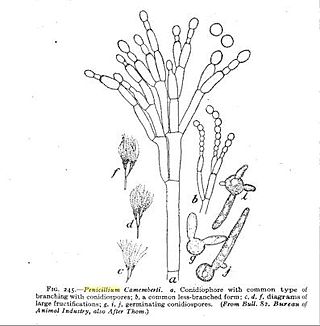
Penicillium is a genus of ascomycetous fungi that is part of the mycobiome of many species and is of major importance in the natural environment, in food spoilage, and in food and drug production.

Penicillium roqueforti is a common saprotrophic fungus in the genus Penicillium. Widespread in nature, it can be isolated from soil, decaying organic matter, and plants.

Penicillium camemberti is a species of fungus in the genus Penicillium. It is used in the production of Camembert, Brie, Langres, Coulommiers, and Cambozola cheeses, on which colonies of P. camemberti form a hard, white crust. It is responsible for giving these cheeses their distinctive flavors. An allergy to the antibiotic penicillin does not necessarily imply an allergy to cheeses made using P. camemberti.

Penicillium chrysogenum is a species of fungus in the genus Penicillium. It is common in temperate and subtropical regions and can be found on salted food products, but it is mostly found in indoor environments, especially in damp or water-damaged buildings. It has been recognised as a species complex that includes P. notatum, P. meleagrinum, and P. cyaneofulvum. Molecular phylogeny has established that Alexander Fleming's first discovered penicillin producing strain is of a distinct species, P. rubens, and not of P. notatum. It has rarely been reported as a cause of human disease. It is the source of several β-lactam antibiotics, most significantly penicillin. Other secondary metabolites of P. chrysogenum include roquefortine C, meleagrin, chrysogine, 6-MSA YWA1/melanin, andrastatin A, fungisporin, secalonic acids, sorbicillin, and PR-toxin.

Penicillium rubens is a species of fungus in the genus Penicillium and was the first species known to produce the antibiotic penicillin. It was first described by Philibert Melchior Joseph Ehi Biourge in 1923. For the discovery of penicillin from this species Alexander Fleming shared the Nobel Prize in Physiology or Medicine in 1945. The original penicillin-producing type has been variously identified as Penicillium rubrum, P. notatum, and P. chrysogenum among others, but genomic comparison and phylogenetic analysis in 2011 resolved that it is P. rubens. It is the best source of penicillins and produces benzylpenicillin (G), phenoxymethylpenicillin (V) and octanoylpenicillin (K). It also produces other important bioactive compounds such as andrastin, chrysogine, fungisporin, roquefortine, and sorbicillins.

Vermistatin is an organic compound and a metabolite of mine-dwelling Penicillium vermiculatum found in Berkeley Pit Lake, Butte, Montana. Penisimplicissin is a vermistatin analog with anticancer activity.
Fungal isolates have been researched for decades. Because fungi often exist in thin mycelial monolayers, with no protective shell, immune system, and limited mobility, they have developed the ability to synthesize a variety of unusual compounds for survival. Researchers have discovered fungal isolates with anticancer, antimicrobial, immunomodulatory, and other bio-active properties. The first statins, β-Lactam antibiotics, as well as a few important antifungals, were discovered in fungi.
Penicillium brefeldianum is an anamorph fungus species of the genus of Penicillium which produces Brefeldin A a fungal metabolite.
Penicillium brocae is a fungal species of the genus Penicillium, which was isolated in Chiapas in Mexico. It is a symbiont of the mangrove tree Avicennia marina.
Penicillium alfredii is a fungus species of the genus of Penicillium which is named after Alfred P. Sloan.
Penicillium citrinum is an anamorph, mesophilic fungus species of the genus of Penicillium which produces tanzawaic acid A-D, ACC, Mevastatin, Quinocitrinine A, Quinocitrinine B, and nephrotoxic citrinin. Penicillium citrinum is often found on moldy citrus fruits and occasionally it occurs in tropical spices and cereals. This Penicillium species also causes mortality for the mosquito Culex quinquefasciatus. Because of its mesophilic character, Penicillium citrinum occurs worldwide. The first statin (Mevastatin) was 1970 isolated from this species.
Penicillium clavistipitatum is a fungus species of the genus of Penicillium.
Penicillium coralligerum is a species of the genus of Penicillium. It is a marine species sometimes referred to as a deep-sea fungus and in some languages named the equivalent of "deep-sea mold".
Penicillium duclauxii is an anamorph species of the genus of Penicillium which produces xenoclauxin and duclauxin.
Penicillium janczewskii is an anamorph and filamentous species of the genus of Penicillium which was isolated from the rhizosphere of Vernonia herbacea. Penicillium janczewskii produces griseofulvin
Penicillium paradoxum is a species of fungus in the genus Penicillium. Penicillium paradoxum grows on dog dung and is phototropic, and has a characteristic odour. Unusual for Penicillium, the fungus has an Aspergillus-like conidial head, not a penicillus.
Penicillium paxilli is an anamorph, saprophytic species of the genus Penicillium which produces paxilline, paxisterol, penicillone, pyrenocine A, paspaline B and verruculogene. Penicillium paxilli is used as a model to study the biochemistry of the indol-diterepene biosynthesis

Penicillium solitum is an anamorphic, mesophilic, salinity-tolerant, and psychrotolerant species of fungus in the genus Penicillium. It is known to produce various compounds including polygalacturonase, compactin, cyclopenin, cyclopenol, cyclopeptin, dehydrocompactin, dihydrocyclopeptin, palitantin, solistatin, solistatinol, viridicatin, viridicatol.
Penicillium sumatrense is a species of fungus in the genus Penicillium which was isolated from the rhizosphere of the plant Lumnitzera racemosa. Penicillium sumatrense produces sumalarin A, sumalarin B, sumalarin C






